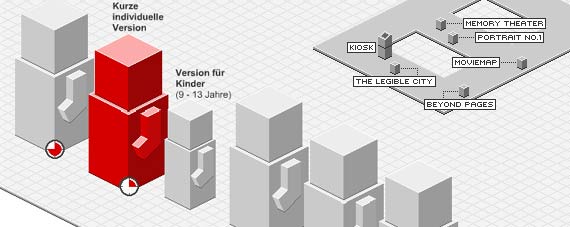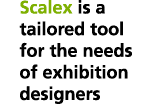This section describes the hardware structure of the overall system. In the following sections a more detailed description about the different hardware components is given.
Server The central element of SCALEX is a server. The server is a single point for maintaining software and digital multi media content of an exhibition. If high availability is a requirement, a backup server with the same functionality and with the same data will be used. Both servers together build a unit, so that clients do not know if the response comes from the server or the backup server. The circumstance that the server is the central point for software components and multi media content does not mean, that every processing step is done by the server and that every request for digital multi media content is fulfilled by the server. The main software component running on the server is a J2EE compatible servlet engine, i.e. APACHE Tomcat. Furthermore Topic Maps for Java (TM4J) and the database Ocean will be used. Java will be used as the throughout the whole system.Room Controller The main functions of the room controller are to control the devices of one exhibition room and to play the role of a sub-server for this room. A proxy is running on a room controller. This proxy tries to fulfil the requests from the display controllers. A possible implementation of such a proxy could be an adapted Jigsaw from W3C. Digital multimedia content parts are replicated and stored in a local cache by the room controller. This means that only not locally existing parts have to be requested from the server. This should help SCALEX to preserve scalability. Room controllers are able to present a default presentation if the server is down or unreachable. Another important task of the room controller is to control what each display in the room is actually showing.
Display Controller On the display controller customized web browser clients show the content, which comes from the room controller. Devices used by the display controllers are video beamer, CRT/LCD monitors and touch screens for displaying. Web cams, microphones and other devices are used as input devices by the display controller. Java applications have to control the input devices and sensors. These applications communicate with the other components in the SCALEX architecture. The question whether display controllers need proxies similar to the proxies on the room controller or if customized web browsers are sufficient, must be evaluated in the prototype phase. For the presentation of content to the visitor Macromedia Flash MX files will be used. A messaging system based on simple socket connections and XML messages is used for inter-component communication and synchronisation issues. PDA’s are connected temporally to display controllers, but room controllers are responsible for the PDA’s.
Editing PC Exhibition makers will use standard PC’s for creating and editing SCALEX based exhibitions as well as for the creation of the digital multimedia content that is presented to the visitors. I/O Devices Within SCALEX different I/O devices can be used. Screens of different sizes can be used for the presentation. These are for example standard computer monitors or touchscreens, either CRT’s or LCD’s, large-scale projection systems with beamers or small mobile devices, i.e. PDA’s. Some of these output devices also allow the visitor to interact with the system, e.g. touchscreens. Other input devices for offering interactivity will for example be cameras (simple WebCam’s) or microphones. But also other sensors for opening an input channel into the system can be thought of.


